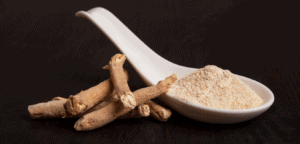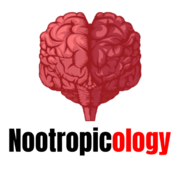5 Benefits of Shoden Ashwagandha as a Nootropic
Ashwagandha, also known as the Indian ginseng, winter cherry and Withania somnifera, is a plant native to India.
Traditionally used in Ayurvedic medicine, ashwagandha has been shown to be beneficial for mental and physical health.
In this article, we will explore 5 ways that Shoden Ashwagandha can benefit your brain and body!
So without further ado, let's just get straight into it, shall we?
How Shoden Ashwagandha is Beneficial

Ashwagandha works by increasing GABA levels in the brain.
GABA is a neurotransmitter that helps to calm down excitatory nerve cells, which reduces feelings of anxiety and stress while promoting relaxation.
This can be especially helpful for those who are recovering from drug addiction as it allows them to cope with their withdrawal symptoms without feeling overwhelmed by fear or worry about cravings.
Shoden Ashwagandha also acts as an antioxidant by protecting neurons in the brain from oxidative damage.
Antioxidants protect healthy cells and promote increased production of neurotrophic factors, which help to create new neurons in your brain.
This is especially helpful for those recovering from addiction because it helps with neuroplasticity so that your brain can heal and form new connections as you recover.
Shoden Ashwagandha has been shown to increase focus, memory, and attention by promoting the growth of dendrites in neurons.
This helps cells communicate more effectively with each other which is an essential part of forming memories and processing information quickly and efficiently.
Shoden Ashwagandha also helps to support healthy testosterone levels in men which is beneficial for both your brain and body.
Higher testosterone leads to greater muscle mass, stronger bones, increased libido, more confidence, and better sleep quality.
5. Increased Physical Performance
According to this study, Ashwagandha was shown to increase swimming performance in rats.
The anti-stress effects of Ashwagandha have been investigated in all of these studies using adult rats subjected to a swimming endurance stress test.
The swimming duration of treated animals was significantly longer than the control group.
The control group swam for a mean of 385 minutes, whereas the mice that had received Ashwagandha continued to swim for a mean duration of 740 minutes.
When compared to the control group, the Ashwagandha treatment increased swimming duration by approximately 50%.
4. GABA-mimetic Effect
The GABA-mimetic activity of Ashwagandha root extract has been bolstered by behavioral research.
Tardive dyskinesia is a neurological syndrome caused by neuroleptic drug use. It is characterized by abnormal choreoathetosis and motor impairment, as well as alterations in the GABAergic nervous system (Gunne et al., 1993). GABA agonists have been found to help alleviate the symptoms of tardive dyskinesia.
The positive impact of the Ashwagandha root extract might be due to its GABA mimetic activity. After taking it for 7 days, ashwagandha, its components, and the metabolites of its components promote nerve development.
Chronic oral administration of withanoside IV reduced the axonal, dendritic, and synaptic losses and memory impairments induced by amyloid peptide Aβ(25–35) in mice (Kuboyama et al., 2006).
Withanoside IV was converted to sominone following oral administration in mice, which significantly improved neurites and synapses and enhanced axonal and dendritic outgrowth and synaptogenesis.
The effects were sustained for at least 7 days after stopping withanoside IV therapy.
These findings suggest that withanoside IV and its metabolite, sominone, may have medical applications as anti-dementia medicines.
3. Anxiolytic Effect
According to this study, Ashwagandha produced a soothing anxiolytic effect that was comparable to Lorazepam in all three Anxiety tests:
- The elevated plus-maze
- Social interaction
- and feeding latency in an unfamiliar environment
Furthermore, when rat brain levels of tribulin, an endocoid marker of clinical anxiety, were increased after administration of the anxiogenic agent, pentylenetetrazole, both Ashwagandha and Lorazepam decreased them.
In two standardized tests, the ‘forced swim-induced behavioral despair' and ‘learned helplessness,' ashwagandha also demonstrated an antidepressant effect, comparable to that produced by imipramine.
The studies validate Ashwagandha's use as a mood stabilizer in anxious and depressive disorders.
2. Energy Levels and Mitochondrial Health
According to this study, the mechanism of action of Ashwagandha was investigated.
The impact of Ashwagandha on glycosaminoglycan synthesis in carrageenan-induced air pouch granuloma granulation tissue was examined.
Ashwagandha was discovered to have a substantial inhibitory effect on the ribosome -35S protein incorporation into granulation tissue.
The uncoupling effect on oxidative phosphorylation (ADP/O ratio reduction) was also seen in granulation tissue's mitochondria.
Ashwagandha also reduced succinate dehydrogenase enzyme activity in granulation tissue.
Mg2+-dependence of ATPase activity was discovered to be affected by Ashwagandha.
These findings indicate that Ashwagandha is useful for improving mitochondrial health, increasing ATP generation, and promoting recovery from fatigue during periods of disease or exercise stress.
1. Anti-inflammatory Benefits
In this study, the effects of Ashwagandha on inflammation were investigated.
Tumor necrosis factor-alpha (TNFα) is a cytokine produced by macrophages and lymphocytes that mediates cell activation and inflammation.
It induces apoptosis in various cells including lymphoid cells, intestinal epithelial cells, keratinocytes, and pancreatic islets.
TNFα increases the expression of a wide variety of genes involved in cell apoptosis, growth arrest, angiogenesis inhibition, invasion, and metastasis through the NF-κB signaling cascade.
Ashwagandha extract inhibited TNFα production by suppressing activation of cellular IKK/NF-κB signaling cascade.
These findings indicate that the anti-inflammatory properties of Ashwagandha root extract are mediated through inhibition of TNFα production by suppressing the cellular IKK/NF-κB pathway.
